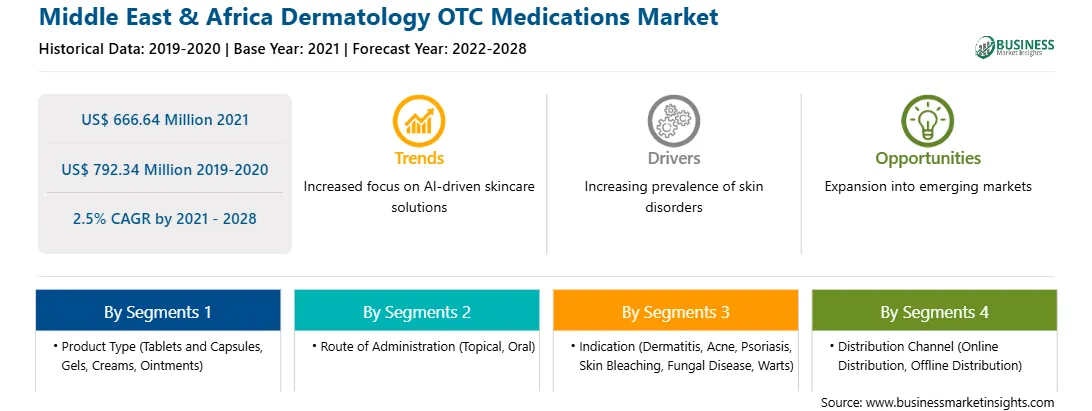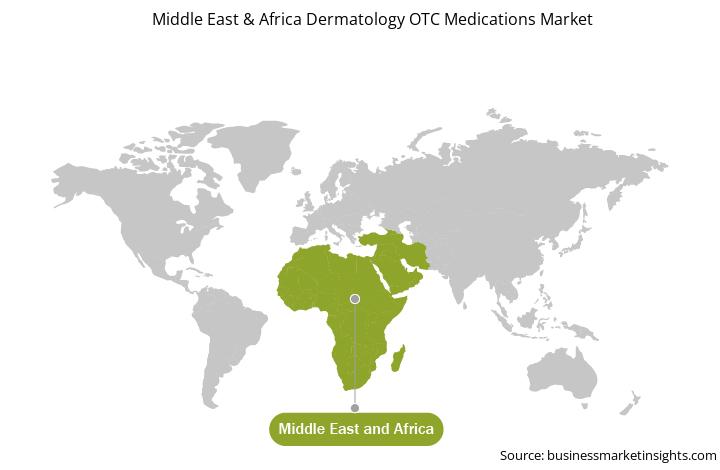With the new features and technologies, vendors can attract new customers and expand their footprints in emerging markets. This factor is likely to drive the MEA dermatology OTC medications market. The MEA dermatology OTC medications market is expected to grow at a good CAGR during the forecast period.
Strategic insights for the Middle East & Africa Dermatology OTC Medications provides data-driven analysis of the industry landscape, including current trends, key players, and regional nuances. These insights offer actionable recommendations, enabling readers to differentiate themselves from competitors by identifying untapped segments or developing unique value propositions. Leveraging data analytics, these insights help industry players anticipate the market shifts, whether investors, manufacturers, or other stakeholders. A future-oriented perspective is essential, helping stakeholders anticipate market shifts and position themselves for long-term success in this dynamic region. Ultimately, effective strategic insights empower readers to make informed decisions that drive profitability and achieve their business objectives within the market.

| Report Attribute | Details |
|---|---|
| Market size in 2021 | US$ 666.64 Million |
| Market Size by 2028 | US$ 792.34 Million |
| Global CAGR (2021 - 2028) | 2.5% |
| Historical Data | 2019-2020 |
| Forecast period | 2022-2028 |
| Segments Covered |
By Product Type
|
| Regions and Countries Covered | Middle East and Africa
|
| Market leaders and key company profiles |
The geographic scope of the Middle East & Africa Dermatology OTC Medications refers to the specific areas in which a business operates and competes. Understanding local distinctions, such as diverse consumer preferences (e.g., demand for specific plug types or battery backup durations), varying economic conditions, and regulatory environments, is crucial for tailoring strategies to specific markets. Businesses can expand their reach by identifying underserved areas or adapting their offerings to meet local demands. A clear market focus allows for more effective resource allocation, targeted marketing campaigns, and better positioning against local competitors, ultimately driving growth in those targeted areas.

The MEA dermatology OTC medications market is segmented intoproduct type, route of administration, indication, distribution channel, and country. Based on product type, the market is segmented into tablets and capsules, gels, creams and ointments, and others. The creams and ointments segment dominated the market in 2020; however, the tablets and capsules segment is expected to be the fastest growing segment during the forecast period. Based on route of administration, the market is segmented into topical and oral. The topical segment dominated the market in 2020; however, the oral segment is expected to be a faster growing segment during the forecast period. Based on indication, the market is segmented into dermatitis, acne, psoriasis, skin bleaching, fungal disease, warts, and others. The acne segment dominated the market in 2020 and is expected to be the fastest growing segment during the forecast period. The dermatitis segment is further classified into atopic dermatitis, contact dermatitis, and others. The acne segment is also segmented into non-inflammatory acne and inflammatory acne. The psoriasis segment is segmented into plaque psoriasis, guttate psoriasis, and others. The fungal disease is further segmented into athlete's foot, ringworm, fungal nail infections, and others. Moreover, the warts segment is further segmented into common warts, flat warts, and others. Based on distribution channel, the market is segmented into online distribution and offline distribution. The offline distribution segment dominated the market in 2020; however, the online distribution segment is expected to be a faster growing segment during the forecast period. The offline distribution is further segmented into retail and hospital pharmacies and super and hypermarkets. Based on country, the market is segmented into the UAE, Saudi Arabia, South Africa, and the Rest of the MEA.
Bausch Health Companies Inc.; Bayer AG; Dr. Reddy's Laboratories; Galderma; GlaxoSmithKline plc.; Johnson and Johnson Services, Inc.; LEO Pharma A/S; Perrigo Company plc; and Viatris Inc. are among the leading companies in the MEA dermatology OTC medications market.
The Middle East & Africa Dermatology OTC Medications Market is valued at US$ 666.64 Million in 2021, it is projected to reach US$ 792.34 Million by 2028.
As per our report Middle East & Africa Dermatology OTC Medications Market, the market size is valued at US$ 666.64 Million in 2021, projecting it to reach US$ 792.34 Million by 2028. This translates to a CAGR of approximately 2.5% during the forecast period.
The Middle East & Africa Dermatology OTC Medications Market report typically cover these key segments-
The historic period, base year, and forecast period can vary slightly depending on the specific market research report. However, for the Middle East & Africa Dermatology OTC Medications Market report:
The Middle East & Africa Dermatology OTC Medications Market is populated by several key players, each contributing to its growth and innovation. Some of the major players include:
The Middle East & Africa Dermatology OTC Medications Market report is valuable for diverse stakeholders, including:
Essentially, anyone involved in or considering involvement in the Middle East & Africa Dermatology OTC Medications Market value chain can benefit from the information contained in a comprehensive market report.